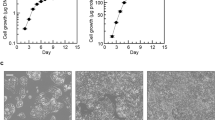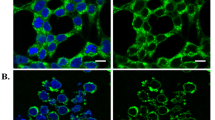Abstract
The phospholipid component of interphase nuclei was analysed in EUE cells (an established cell line from embryonic human epithelium) grown in an isotonic culture medium and during the adaptation process to a hypertonic medium, using a highly specific ultracytochemical procedure, viz. labelling with the phospholipase A2 gold-complex. Within the nucleus, the phospholipids were localized in domains involved in different steps of the synthesis and processing of the RNA. These localizations did not vary at the two key steps of the adaptation process to hypertonic medium: short-term treatment (6 h) representing critical shock condition, and long-term growth (5 days) representing the adapted cells under survival conditions. On the contrary, deep changes of the labelling intensity of phospholipids at these sites occurred at the different times of hypertonic treatment and followed the same course as those observed in the ultramorphological patterns of transcription: the chromatin condensation, as evaluated by image analysis, the permanent nucleolar components, the interchromatin and the perichromatin granules. These data endorse the hypothesis that nuclear phospholipids could be involved in different steps of the transcriptional activity. They are indicative of the deep changes occurring in the EUE cells submitted to hypertonic stress.
Similar content being viewed by others
References
Albi E, Viola Magni MP, Lazzarini R, Gahan PB (1991) Chromatin phospholipids changes during rat liver development. Cell Biochem Funct 9:119–123
Ansell GB, Spanner S (1982) Phosphatidylserine, phosphatidylethanolamine and phosphatidylcholine. In: Hawthorne JN, Ansell GB (eds) Phospholipids. Elsevier Biomedical Press, Amsterdam, pp 1–49
Asaoka Y, Yoshida K, Oka M, Shinomurat T, Mishima H, Matsushima S, Nishizuma Y (1992) The signal-induced phospholipid degradation cascade on protein kinase C activation. In: Sato R, Bock GR (eds) Interactions among cell signalling systems. (Ciba Foundation Symposium 164) Wiley & Sons, Chichester.
Baker JR (1946) The histochemical recognition of lipines. Q J Microsc Sci 87:441–447
Bendayan M (1981) Ultrastructural localization of nucleic acids by the use of enzyme-gold complexes. J Histochem Cytochem 29:531–541
Bendayan M (1984) Enzyme-gold electron microscopy cytochemistry: a new affinity approach for the ultrastructural localization of macromolecules. J Electron Microsc Tech 1:349–372
Bendayan M (1985) The enzyme-gold technique: a new cytochemical approach for the ultrastructural localization of macromolecules. In: Bullock GRB, Petrusz P (eds) Techniques in immunohistochemistry, vol 3. Academic Press, London. pp 179–201
Berridge MJ (1987) Inositol lipids and cell proliferation. Biochim Biophys Acta 907:33–45
Bolognani L (1979) Biochemical features of epithelioid human cells (EUE) cultured in hyperosmotic medium. Basic Appl Histochem 32 [Suppl.]: 41–45
Bolognani L, Fuhrman Conti AM, Omodeo Sale' MF (1976) Studies on polar lipids in human cultured cells adapted to hypertonic medium. Biochem Exp Biol 12:167–173
Bolognani L, Bolognani Fantin AM, Castellana C, Fuhrman Conti AM, Giuliani A, Sabatini MA, Sanguini CL, Silvestri MG, Tricoli S (1985) Enzymatic characterization of EUE (embryonal human explants) cells adapted to hypertonic media. Acta Histochem 76:1–11
Bolognani Fantin AM, Franchini A, Fuhrman Conti AM, Corbascio GC, Marchisio PC (1988) Effects of hypertonic conditions on cytoskeletal and adhesion structures of EUE cells. Eur J Cell Biol 47:327–333
Bradbury S (1983) Commercial image analyzers and the characterization of microscopical images. J Microse 131:203–210
Capitani S, Caramelli E, Matteucci A, Santi P, Mottola MR, Manzoli FA (1987) Influence of phosphatidylserine on endogenous RNA synthesis in isolated liver nuclei. Basic Appl Histochem 31:389–412
Capitani S, Helmes B, Mazzoni M, Previati M, Bertagnolo V, Weitz KWA, Manzoli FA (1990) Uptake and phosphorylation of phosphatidylinositol by rat live nuclei. Role of phosphatidylinositol transfer protein. Biochim Biophys Acta 1044:193–200
Coulombe PA, Frederick WKK, Bendayan M (1988) Introduction of a high-resolution cytochemical method for studying the distribution of phospholipids in biological tissues. Eur J Cell Biol 46:546–576
Divecha N, Banfic H, Irvine RF (1991) The polyphosphoinositide cycle exists in the nuclei of Swiss 3T3 cells under the control of a receptor (for IGF-1) in the plasma membrane, and stimulation of the cycle increases uclear diacylglycerol and apparently induces translocation of protein kinase C to the nucleus. EMBO J 10:3207–3214
Divecha N, Banfic H, Irvine RF (1993) Inositides and the nucleus and inositides in the nucleus. Cell 74:405–407
Fakan S (1986) Structural support for RNA synthesis in the cell nucleus. In: Jasmin J, Simard R (eds) Methods and achievements in experimental pathology, vol 12. Nuclear submicroscopy. Karger, Basel, pp 105–140
Fakan S (1994) Perichromatin fibrils are “in situ” forms of nascent transcipts, Trends Cell Biol 4:86–90
Ferraretto A, Negri A, Giuliani A, De Grada L, Fuhrman Conti AM, Ronchi S (1993) Aldose reductase is involved in longterm adaptation of EUE cells to hyperosmotic stress. Biochim Biophys Acta 175:283–288
Fraschini A, Fuhrman Conti AM, Pellicciari C (1989) Short- and long-term response of EUE cells to the hypertonic stress: ultrastructural and cytochemical patterns. Basic Appl Histochem 33 (Suppl): 48
Fraschini A, Albi E, Gahan PB, Viola Magni MP (1992) TEM cytochemical study of the localization of phospholipids in interphase chromatin in rat hepatocytes. Histochemistry 97:225–235
Fuhrman Conti AM (1979) Cytological and genetic features of mammalian cultured cells adapted to hypertonic medium. Basic Appl Histochem 23 [Suppl]: 51–57
Ghysdael J,Yaniv M (1991) Nuclear oncogenes. Curr Opin Cell Biol 3:484–492
Giuliani A, Ferraretto A, Fuhrman Conti AM, De Grada L, Fraschini A, Pellicciari C, Manfredi Romanini MG (1991) A 33 kDa protein band is enhanced during long-term adaptation of EUE cells to a hypertonic medium. Cell Biochem Funct 9:87–94
Haaf T, Schmid M (1991) Chromosome topology in mammalian interphase nuclei. Exp Cell Res 192:325–332
Hollywood D (1991) Signal transduction. Br Med Bull 47:99–115
Hutchinson N, Weintraub H (1985) Localization of DNAse I-sensitive sequences to specific regions of interphase nuclei. Cell 43:471–482
Irvine RF (1992) Inositol lipids in cell signalling. urr Opin Cell Biol 4:212–219
Irvine RF, Divecha N (1992) Phospholipids in the nucleus — metabolism and possible functions. Semin Cell Biol 3:225–233
Manfredi Romanini MG, Fraschini A, Fuhrman Conti AM, Gasperi G, Mazzini G, Marchese G, Pellicciari C (1987) Cell response to the hypertonic stress: preliminary results on the variation of protein patterns and cell kinetics. Acta Embryol Morphol Exp 8:151–158
Manfredi Romanini MG, Fraschini A, fuhrman Conti AM, Gasperi G, Giuliani A, Pellicciari C (1990) Changes of gene expression during long-term adaptation of human EUE cells to a hypertonic medium: electrophoretic protein patterns and DNAse I digestion “in situ”. Acta Histochem 38 (Suppl): 233–237
Maraldi NM, Capitani S, Caramelli E, Becco L, Bernabei O, Manzoli FA (1984) Conformational changes of nuclear chromatin related to phospholipid-induced modifications of the template activity. Adv Enzyme Regul 22:447–464
Maraldi NM, Zini N, Squarzoni S, Del Cocco R, Sabatelli P, Manzoli FA (1992) Intranuclear localization of phospholipids by ultrastructural cytochemistry. J Histochem Cytochem 40:1383–1392
Monneron A (1966) Utilization de la pronase en cytochime ultrastructurale. J Microsc 5:583–596
Monneron A, Bernhard W (1966) Action de certaines enzymes sur des tissus inclus en Epon. J Microsc 5:697–714
Moyne G (1980) Methods in ultrastructural cytochemistry of the cell nucleus. Progr Histochem Cytochem 13:1–72
Pellicciari C, Mazzini G, Fuhrman Conti AM, De Grada L, Manfredi Romanini MG (1989) Effects of hypertonic medium on human cell growth: III. Changes in cell kinetics of EUE cells. Cell Biol Int Rep 13:345–356
Pellicciari C, Danova M, Giordano M, Fuhrman Conti AM, Mazzini G, Wang E, Ronchetti E, Riccardi A, Manfredi Romanini MG (1991) Expression of cell cycle related proteins — proliferating cell nuclear antigen (PCNA) and statin — during adaptation and deadaptation of EUE cells to a hypertonic medium. Cell Prolifer 24:469–479
Pellicciari C, Viale G, Fraschini A, Giuliani A, Gaspari A, De Grada L, Fuhrman Conti AM, Manfredi Romanini MG (1993) Light and electron microscope immunolabelling and flow cytometric evaluation of a 33 KDa stress protein during the cell cycle of EUE cells grown in hypertonic medium. Acta Histochem Cytochem 26:11–19
Puvion Dutilleul F, Bachellerie J, Puvion E (1991) Nucleolar organization of HeLa cells as studied by in situ hybridization. Chromosoma 100:395–409
Raska I, Dundr M, Koberna K (1992) Structure-function subcompartments of the mammalian cell nucleus as revealed by the electron microscopic affinity cytochemistry. Cell Biol Int Rep 16:771–789
Schwarzacher HG, Wachtler F (1983) Nucleolar organizing regions and nucleoli. Hum Genet 63:89–99
Spector DL (1990) Higher order nuclear organization: three-dimensional distribution of small nuclear ribonucleoprotein particles. Proc Natl Acad Sci USA 87:147–151
Spector DL (1993) Macromolecular domains within the cell nucleus. Annu Rev Cell Biol 9:265–315
Spector DL, Fu XD, Maniatis T (1991) Associations between distinct pre-mRNA splicing components and the cell nucleus. EMBO J 10:3467–3481
Terashima M, Tolmach LJ (1961) Changes in X-ray sensitivity of the HeLa cells during the division cycle. Nature 190:1210–1211
Terni M, Lo Monaco BB (1985) Coltura continua di cellule derivate da embrione umano. Lo Sperimentale 108:177–185
Thiry M (1993) DNase I-sensitive sites within the nuclear architecture visualized by immunoelectron microscopy. DNA Cell Biol 10:169–180
Thiry M (1993) Ultrastructural distribution of DNA and RNA within the nucleolus of human Sertoli cells as seen by molecular immunocytochemistry. J Cell Sci 105:33–39
Viola Magni MP, Gahan PB, Albi E, Iapoce R, Gentilucci PF (1986) Phospholipids in chromatin: incorporation of [32P]O 2−4 in different subcellular fractions of hepatocytes. Cell Biochem Funct 4:283–288
Viola Magni MP, Gahan PB, Pacy J (1985) Phospholipids in plant and animal chromatin. Cell Biochem Funct 3:71–78
Visa N, Puvion Dutilleul F, Bachellerie JP, Puvion E (1993a) Intranuclear distribution of U1 and U2 sn RNAs visualized by high resolution in situ hybridization: revelation of a novel compartment containing U1 but not U2 snRNA in HeLa cells. Eur J Cell Biol: 60, 308–321
Visa N, Puvion Dutilleul F, Harper F, Bachellerie JP, Puvion E (1993b) Intranuclear distribution of Poly(A) RNA determined by electron microscope in situ hybridization. Exp Cell Res: 208, 19–34
Wachtler F, Stahl A (1993) The nucleolus: a structural and functional interpretation. Micron 24:473–505
Wang E (1989) Statin, a nonproliferation-specific protein, is associated with the nuclear envelope and is heterogeneously distributed in cells leaving quiescent state. J Cell Physiol 140:418–426
Wang E, Kreuger JG (1985) Application of a unique monoclonal antibody as a marker for non-proliferating sub-populations of cells of some tissues. J Histochem Cytochem 33:587–594
Weisbrod S (1982) Active chromatin. Nature 297:289–295
Whitman M, Cantley L (1988) Phosphoinositide metabolism and the control of cell proliferation. Biochim Biophys Acta 948:327–344
Author information
Authors and Affiliations
Rights and permissions
About this article
Cite this article
Fraschini, A., Fuhrman Conti, A.M. Nuclear phospholipids during the adaptation of human EUE cells to hypertonic stress. Histochem Cell Biol 103, 47–57 (1995). https://doi.org/10.1007/BF01464475
Accepted:
Issue Date:
DOI: https://doi.org/10.1007/BF01464475




